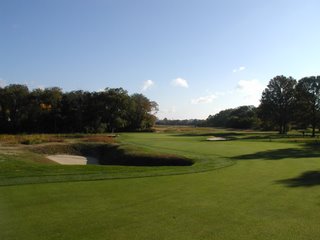Bunker Week – Part 2 – Why we need bunkers

The bunker on the left defines the strategy of the tee shot
While bunkers are inconvenient and frustrating to the player, they are essential to the core spirit of the game. They are used, in combination with other hazards, to define the risk and set the requirements of the hole. They are the architect’s most common tool to force players to make decisions and to think.
Willian Flynn describes the role of the architect best when he said,“The principle consideration of an architect is to hold the interest of a player from the first tee to the last green” I can not find a better quote to explain our role. Please notice how at no point he mentioned the words difficulty or challenge! The way we create interest is by careful placement of bunkering and other hazards to creates decisions. Decisions lead to strategy and options, and as Bobby Weed always like to say over and over again, “Options equal interest.”
Max Behr one of the greatest writers on golf of all time had a beautiful explanation what golf architects are trying to accomplish with bunker placement. “The direct line to the hole is called the line of instinct, and to make a great hole you must break up that line in order to create a line of charm. The line of charm is the provocative path that shaves off distance and provides an ideal an ideal line into the green, usually by skirting bunkers and other hazards. The golfer wants the most direct line he can find to the hole, while the architect uses bunkers and other hazards to create risk and reward options that suggest the ideal line for the player, or the line of charm.”
Imagine a hole that has no bunkers, or more importantly any other deterrent to playing directly at the hole. The hole is simply a test of a prescribed length requiring a set of shots to reach the putting surface. Now if there is even one bunker added to the front left of the green, the ideal tee shot is down the right to open up the angle in. Now there is a rudimentary strategy. Add a bunker placed in the right rough and you have a situation where you need to skirt that bunker for the ideal line, and the strategy is stronger. That is the first basic of strategic bunker placement.
The most rudimentary of strateges, flirt the bunker to achieve the ideal line
If that were it, and it is for some architects, then we would all understand how to break down great architecture…but it’s not. Consider Alister Mackenzie’s quote of, “No hole is a good hole unless it has one or more hazards in the direct line of the hole” Why not in the middle of play like the Principles Nose at St. Andrew’s. This may be another of the finest bunkers in the history of the game. The bunker is exactly where you want to play to. Play safely to the left but receive a much tougher angle; play right, risking the out of bounds, and get rewarded with the ideal approach line. That is a superior fairway bunker placement and outstanding strategy. This also must open your eyes to realize that the options and reasons for placement are becoming limitless.
Next up Depth: http://thecaddyshack.blogspot.com/2006/10/bunker-week-part-3-depth.html

4 comments:
That is what makes this game so great...the strategy of risk / reward, and the never ending challenges on a hole. Also, the mystery of 'what's around the corner?' on a new course that the golfer hasn't played before.
As much as I hate hazards when I invariably end up in them...the game wouldn't be the same without them. Each course would be a glorified driving range.
great articles on bunkers. looking forward to the others.
do you know of any courses in southern ontario, or elsewhere, where there are bunkers in the middle of the fairway ala the principal's nose?
peter
olympia, wa
Peter,
While I am certain Ian can give plenty of examples, the one that comes immediately to mind for me, because I have played the course a few times, is the South Course at The Club at Bond Head. (HF Golf, Jason Straka). It is a long par 5 with 4 bunkers at or near the centreline of the fairway. While I don't think it lends the same level of strategy to the hole that Ian discusses with the Principal's Nose, you certainly have to be aware of them.
Dave
another course would be Glencarin
http://clublink.ca/gallery/glgallery.html
Post a Comment